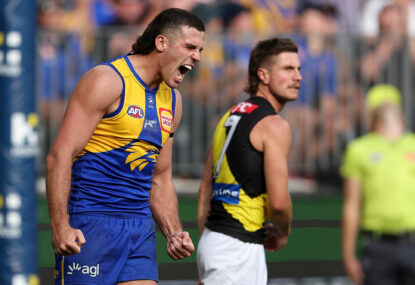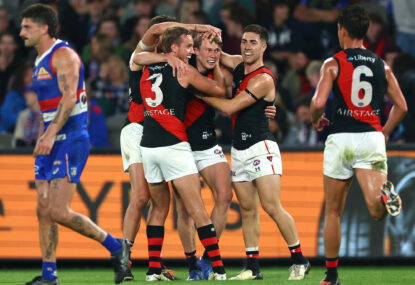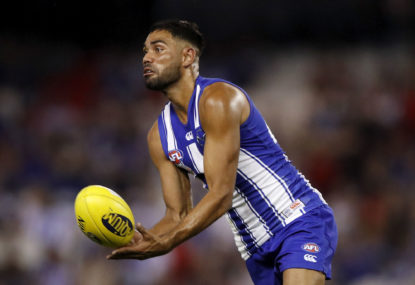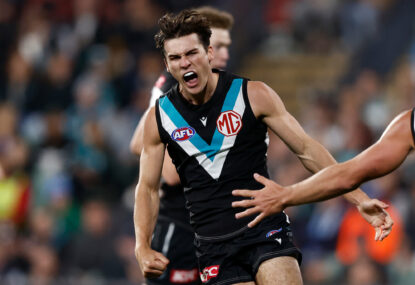The Essendon Bombers own the fifth oldest and most experienced list in the competition. In some ways, and on some days, they’re playing like it. On others, everything falls apart.
Welcome to football’s Frankenstein’s monster, an experiment in team building, yielding surprising results.
We were told Essendon were cooked, their engines burnt out after a fast start to the year. Coach John Worsfold said his players were physically and mentally fatigued after their Round 6 loss to Melbourne.
It looked awfully like a white flag being waved; the last blow of the doping scandal that has plagued the team and competition for six years, and change landing flush on the jaw of the reborn Bombers.
Well, then.
After dispatching the Cats and Eagles in consecutive weeks, with a style of football that is anything but lethargic, Worsfold’s call looks mighty premature. Nine games into the 2017 AFL season, Essendon finds itself in a unique – in the context of modern AFL list construction – position.
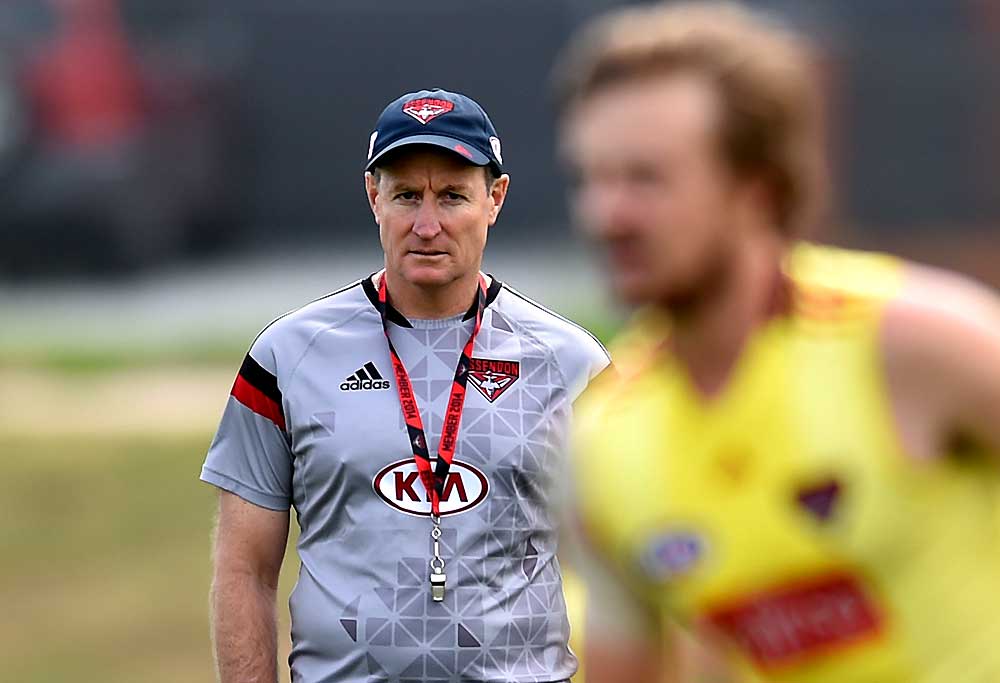
AAP Image/Tracey Nearmy
Essendon’s football evolution, kick started with James Hird’s exit from the club at the tail end of the 2015 season, was stalled by a dozen of their senior players being suspended for the entirety of the 2016 season. The Bombers pressed pause, meandering through a meaningless season (in the grander scheme of things), waiting for their best and brightest to return.
This time last year, the Dons coming off an eight-goal loss against a rebuilding Saints, football competence might as well have been the moon.
There were positives to the malaise, of course. Indeed, they uncovered plenty of diamonds in their ‘sack of coal’ of a season.
Zach Merrett was handed the keys to Essendon’s midfield, running point like a 27-year-old having the time of his life (it was his 20-year-old season). Darcy Parish also showed oodles of potential in an outsize role. Recycled pick-ups James Kelly and Matt Dea have stuck around, and are now entrenched in Worsfold’s best 22.
Orazio Fantasia probably would have languished in the Bombers’ VFL team; instead he’s in All Australian contention as a small forward. Joe Daniher was made to make his own luck, and now he’s doing joyful things on a weekly basis. Ditto Anthony McDonald-Tipungwuti, a second-round rookie pick from 2015, thrust into the best 22 – his chase down tackles already the stuff of football internet mythos.
For it all, the Dons finished last, picking first for the first time in the relatively short history of the draft. That yielded Andrew McGrath, a youngster with the poise and build of a veteran who has played every game in 2017.
These players are now critical to Essendon’s short, medium and long-term future – in varying degrees. Around them, the majority of the Bombers’ suspended players have returned, while pieces from across the league have joined in too. It makes for an intriguing tapestry; a team in some ways caught in the past, but with a significant future ahead.
Here’s a thought exercise: right now, this could be Essendon’s starting five midfielders (I’d say starting six, but the Dons need a ruckman) in the 2020 season – age and a rough approximation of games under their respective belts.
| Player |
Games |
Age |
Draft pedigree |
| David Zaharakis |
213 |
30.1 |
Pick 23 |
| Dyson Heppell |
172 |
27.9 |
Pick 8 |
| Zach Merrett |
125 |
24.5 |
Pick 26 |
| Darcy Parish |
86 |
22.7 |
Pick 5 |
| Andrew McGrath |
66 |
21.8 |
Pick 1 |
That is with Essendon sitting pat and doing nothing but picking and sticking with what they already have.
Phwoar.
Essendon’s midfield is producing mixed results, its youth not quite strong enough here and now, and its veterans only able to provide so much cover. The team’s inside 50 differential is -10.8 on the season, and their adjusted contested possession differential is -2.8 – both in the bottom third of the league.
Yet, as you’ll see below, there are clear signs of a successful, modern system that is yielding results. On that alone, Essendon fans should feel positive about the future.
With five wins in the bank, including two on the bounce, and the halfway mark of the season still a couple of weeks away, a question must be asked: is that future now?
Football identity
Very Serious Football People talk about the need for teams to play with an identity. A brand, “the [insert team name here] way”.
It is one of the constant critiques of Nathan Buckley’s Collingwood – what’s the brand? What’s the football identity? By contrast, brand-name football is Luke Beveridge’s Bulldogs through and through.
It’s not that simple, but it’s not complicated either.
Free of expectation, Worsfold had ample opportunity to experiment with those players he had available. Significantly, it is largely a tweak of former coach Hird’s plan, with a modern twist that has boosted Essendon’s scoring power. The end result is a team with a strong identity and simple game plan that matches its personnel.
Essendon’s preference is to slow play the ball on offence, working it around the ground to open men and progressively moving into a threatening zone on the ground. They do this in almost every circumstance.
Win the ball in the midfield: kick it wide. Exiting an opposition press: kick it wide. A kick-in: kick it wide. Essendon are happy to be patient, allow the play to develop, and force the opposition to work hard to win the ball back.
[latest_videos_strip category=”afl” name=”AFL”]
We see this manifest in their uncontested marking totals: the Dons have taken 100 uncontested marks per game, 20 more than the competition average, and five more than second-ranked Carlton (95.1). Just 9.4 per cent of Essendon’s total marks are contested, the second least in the competition behind Brisbane (8.9 per cent).
Finally, Essendon take almost two uncontested marks per minute of possession, 23 per cent more than league average and almost 60 per cent more than 18th ranked Richmond.
Essendon’s kick-to-handball ratio is 1.41 on the season, again second only to the Blues. If we had access to more sophisticated statistics, I imagine they would say Essendon would lead the league in short kicks, and would perform very well on kick retention for those short kicks. They would also rank near the bottom of the league for use of the centre corridor, preferring instead to stretch their opponents across the width of the ground.
The Dons’ preference is clear: win the ball, get it out wide, hold possession. Except, you know what? It’s not working – at least not as well as the brains trust would like.
Despite their penchant for pushing the ball outside, Essendon have a time in possession differential of -1.0 minutes per game – ranked 11th in the competition. They’re in a clutch of teams that hover around about a break-even rate of ball control, all of whom have very different styles to Essendon.
Essendon are also performing poorly on actually getting the ball inside their scoring zone, both in raw terms (ranked 14th for inside 50 entries) and when adjusted for time in possession (ranked 17th, with the Dons converting their possession into inside 50 entries at almost eight per cent below the competition average).
There is nothing inherently wrong with this: Essendon are scoring 94 points per game, a shade above average. Their points per minute of possession is 1.84 – bang on league average. The data above simply says the competition as a collective has been able to convert possession into territory more efficiently than the Dons.
What’s more stark is the difference between these indicators in wins versus losses. Generally speaking, Essendon take more uncontested marks (112.6 and +40.2 on their opponents in wins, 85.3 and -1.8 on their opponents in losses) and score more per minute of possession (2.04 points versus 1.53 points). When their possession-heavy style comes off, the Dons are able to put points on the board.
It’s a situation made all the more interesting by the way Essendon have sought to play when they find an opening: blistering pace with overlap handballs to a rotating cast of midfield forwards streaming into an open forward 50.
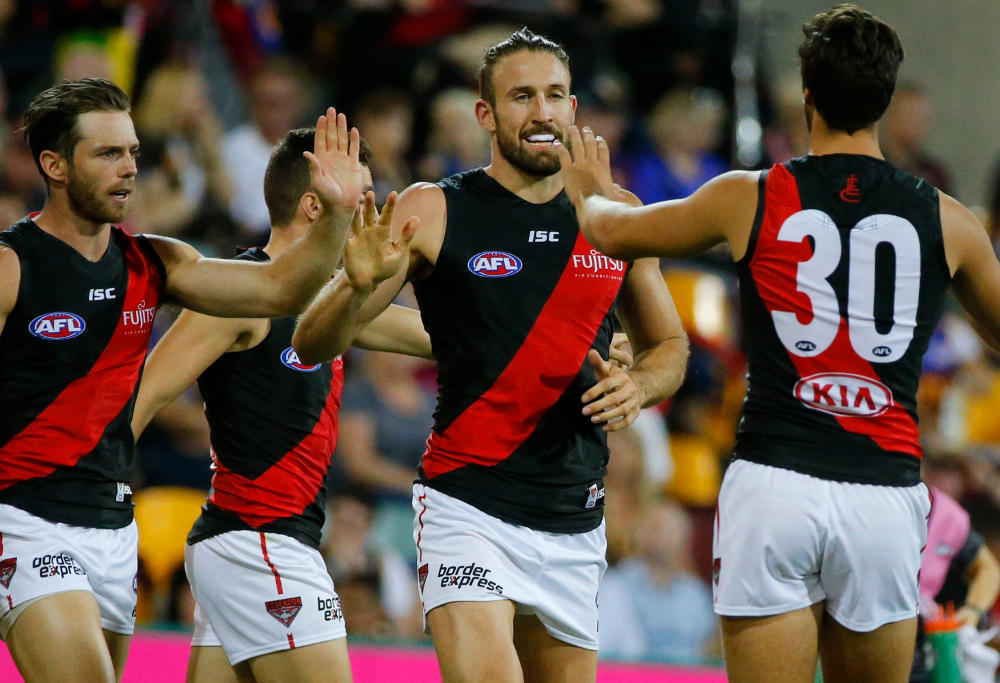
(AAP Image/Glenn Hunt)
Fantasia (pick 55 in the 2013 draft), McDonald-Tipungwuti (a mature age rookie) and Josh Green (delisted free agent) have combined to form one of the most potent small forward line ups in the competition. Between them, they’ve kicked 43 goals through nine, nine and seven games respectively, and recorded 18.7 score involvements as a trio (many of those would overlap, but it’s not possible to determine how many).
They do their best work in open spaces, rather than in congestion or in forward 50 stoppages, as is the traditional lot of a small forward.
When the opportunity presents itself, Essendon loves nothing more than to get the ball into open space to allow their small runners to wreak havoc on scrambling opposition defences.
Essendon’s wins against the Hawks and Cats have been prime examples of this, with play after play breaking through leaky presses and affording their small forwards quality looks at the big sticks. When it works, it works a treat.
Essendon has scored 100 points or more in all five wins, including a season-high score of 125 against West Coast in the weekend just past.
That victory was built as much by a hapless Eagles outfit that turned the ball over with frightening regularity, and who were unable to keep up with Essendon’s outside ball movement. Indeed, the Dons put up 142 uncontested marks on the Eagles, comfortably the most West Coast has conceded in a single game under coach Adam Simpson.
Essendon’s average winning score this season is 112.4 points, ranked seventh in the competition. Triple figures sit there tantalisingly in reach every week.
The only hiccup is scheme: if the Dons get the look they like, nine games of football says they can win. And after the past two fortnight, pedigree be damned.
What comes next? That’s a mystery
After Round 7, Essendon were 3-4, with wins against the teams ranked 16th, 17th and 18th on the ladder and a percentage of 88 per cent.
The Bombers were tired, and we were all a little perplexed as to where they sat in the pecking order. Were they the 15th-best team in a season with a burgeoning middle class? It was not just possible, but likely, and not unexpected.
The Dons are a patchwork team, sown loosely together by the fact they all held contracts penned by Adrian Dorodo. There are the Essendon veterans – banned and otherwise – the top ups, and the new guard, all with vastly different football experiences and talents to offer. Essendon’s marketing department scribbled ‘low expectations’ all over their team’s script in the off season.

AAP Image/Julian Smith
Not so now. Essendon’s two wins against two more highly rated opponents have set supporter expectations alight and seen the punditry – the ones who can think about more complex issues than sledging, tribunal technicalities and contracts – reassess the Dons’ prospects.
From here, Essendon play three top-eight teams leading into the bye: Richmond at the MCG this weekend, whatever is left of the Greater Western Sydney Giants at Spotless Stadium in Round 11, and Port Adelaide at Etihad Stadium as a standalone Saturday night fixture in Round 12. We will know if the past two weeks are real or a mirage before June is out.
Worsfold has played this well.
The story is set: the Dons can be up and down for the next 14 weeks and it is all part of the plan. If there happens to be more down than up, it’s the half a dozen regular faces returning from half a decade of professional purgatory weighing them down, or it’s the youngsters, or it’s the top ups. We’re just tired guys.
But if there’s upside? Then Essendon’s experiment in team building is paying off. A simple but well-executed system with talented players can work with limited time to gel.
The reality is somewhere in the middle, as it always is.
Don’t call it a comeback story; that would be in poor taste, but also underselling what Worsfold and his off-field crew have created for Essendon in their first year post-WADA. Essendon might yet peter out, as Worsfold foreshadowed a month ago; Essendon might yet make a leap and contend for a finals spot in this most even of seasons.
No matter what the short-term outcome, Essendon’s future looks bright, the days of pseudo-science fading further into the rear-view mirror win by win.

































































































